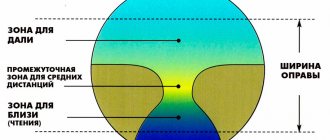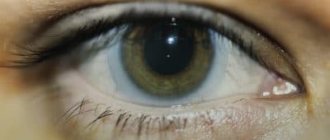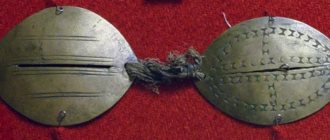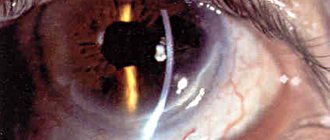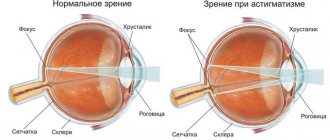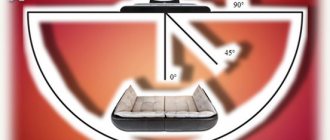Addition is a parameter that determines the difference in diopters between the correction values for the far and near images. In other words, addition determines the optical, or dioptric, power that is required to supplement distance vision, that is, in order to additionally be able to see objects in close proximity.
If we explain this term in simpler words, then we can call addition the difference in the optical power of lenses, which is required for clear visualization of objects located at both far and near distances.
The addition index is available for progressive lenses, which can simultaneously correct vision at three distances: distance, intermediate distance and near.
For example, if glasses for distance have an indicator of +1.0, and for near - +2.0, then the addition indicator will be 1.0. The parameter is abbreviated ADD.
If such a term is mentioned in the prescription, then this indicates progressive glasses.
Addition in ophthalmology is defined as low (low), medium (medium), high (high).
The first degree has an indicator up to +1, medium – from +1.25 to +2, high, respectively, over +2.
Low add lenses facilitate a gradual transition from single vision lenses. Lenses with an average addition index are intended for stable forms of presbyopia, while lenses with a high addition index are intended for severe deviations.
In youth, people distinguish objects with the same dioptres equally well, but with age, conditions change. There is a need to use additional positive diopters.
Addition in persons with myopia and hypermetropia has the same indicators.
Ophthalmologists provide approximate calculations of the addition rate for patients:
- 40 years: +0.5-0.75 diopters (hereinafter referred to as D);
- 45 years: +1-1.25 D;
- 50 years: +1.5-1.75 D;
- 55 years: +2 D;
- 60 years: +2.25-2.5 D;
- 65 years: +2.75-3 D.
The higher the mentioned indicator, the longer it takes for the eyes to get used to it.
Why does presbyopia occur?
A refractive error such as presbyopia occurs in people aged 40-45 years. It is due to the fact that the lens loses its elasticity, becomes hard and stops changing its shape when focusing vision on objects located at different distances from the eyes. As a result, the patient cannot see the world around him independently, without the use of vision-correcting agents.
What are multifocal contact lenses?
One of the simplest ways to correct presbyopia in ophthalmological practice is to use two pairs of glasses with different optical parameters to view objects at different distances. However, it is not very convenient, since it forces you to regularly change glasses depending on the situation, hampers movement and does not allow you to lead an active lifestyle.
Therefore, ophthalmologists recommend choosing the best alternative option for correcting presbyopia - multifocal lenses for the eyes.
The peculiarity of such products is that in each of them several optical zones with different indicators are simultaneously located, so the user can clearly see objects at different distances from him.
The simplest type of multifocal lenses are bifocal ophthalmic products with two optical zones and a clear boundary between them. That is, in the lower part of the lens there is a zone of near vision, and in the upper part there is a zone responsible for good distance vision.
There are also concentric lenses, which have alternating ring zones for viewing objects near and far. In total, such products have 2-3 zones.
The design of concentric contact lenses varies depending on which zone is in the center. In some models, the central circular zone is responsible for distance vision, and around it there is a ring for near vision. It also happens that the central part of the product, on the contrary, is responsible for good quality of vision at a distance.
Light rays hitting the visual organs first pass through all areas of multifocal contact lenses and form an image on the retina. It has been scientifically proven that the human brain selects the necessary image obtained through optical products and forms the final visual image.
Ophthalmologists also recommend choosing aspherical contact optics, which fully replaces progressive spectacle lenses.
In such products, the refractive power changes from the central part to the peripheral part. So, if the central zone is responsible for near vision, when viewing nearby objects, the pupil narrows. Conversely, when looking at an object at a distance, the pupil dilates. Because the transitions between zones in aspheric lenses are quite smooth, they provide excellent vision at intermediate distances.
If, when wearing bifocal lenses, a stable position of the product on the eye is necessary, then concentric and aspheric contact optics do not require this. It is also important to understand that multifocal lenses are not suitable for patients with high add.
Dominance
Multifocal lenses differ in that the optical power in the center and at the periphery is different. This allows them to simulate the functioning of the lens of the human eye. Often, for vision correction, products are used that provide for the presence of a dominant eye. Make one lens - N for the non-dominant eye and another - D for the dominant eye.
The first lens has three progressive eye focusing zones: central, transition and peripheral. The central one guarantees close visibility. Transitional allows you to see at medium distances and switches visibility from close to medium and vice versa. Peripheral allows you to see far away.
The central part of the lens with the letter D is used to correct distance vision. Both lenses have 2 optical centers and 2 designs: spherical and aspherical. The correct selection of lenses provides people with progressive presbyopia with visibility at different distances.
Lens addition: what is it?
Such a parameter as addition in contact lenses is very important when selecting optical products. It shows the optical power, which is necessary as an additional force when viewing distant objects, but at the same time allows you to clearly see close objects. This parameter is indicated in the recipe along with others and is designated “ADD” or “add”. This characteristic may differ in the right and left eyes. Thus, lens addition as a plus addition near is measured as: low - LOW up to +1; average - MEDIUM from 1.25 to +2; high - HIGH over +2.
It is important to understand that on your own, without a vision test by a specialist and his recommendations, you will not be able to choose contact optics that will correct your vision and provide an ideal image, since such a parameter as addition is individual.
Dominance and addition. What else you need to know about eye lenses
In order to choose the right lenses for your eyes, you should first obtain a prescription from an ophthalmologist, which will prescribe all the basic parameters necessary specifically for you, taking into account your individual characteristics.
As a rule, it indicates such items as optical power, radius of curvature, etc. However, if you need to select multifocal lenses, then you should pay special attention to such indicators as addition and dominance, which are characteristic only for this type of optical lens products. What are these parameters?
Multifocal contact lenses are successfully used today to correct presbyopia - age-related farsightedness. This pathology usually develops in people over 40 years of age and is explained by the loss of the lens's former elasticity, due to which it can no longer change shape as before, ensuring clear recognition of objects at any distance. Previously, to prevent this disease, two pairs of glasses were used: one provided good visibility at close range, the other at a distance. However, constant use, and especially regular carrying of two pairs of glasses everywhere, was inconvenient, and that is why experts developed the presented ophthalmic products, which can be bought today in any optician and, of course, in the online contact lens store Ochkov.net.
Dominance
One of the terms that you can hear from a contact specialist is dominance. What does it mean? As a rule, products are used for correction, one of which is designated by the Latin letter N (non-dominant eye), and the other by D (dominant eye). The first has a central visual zone, designed specifically to normalize near vision, after which it develops into an intermediate, and then into a peripheral zone, allowing for correction of vision at a far distance. The contact lens, designated D, has a central zone with a diameter of 2.3 mm and is designed to correct distance vision. Both have a front surface that is a combination of two designs: the time-tested spherical design and the more advanced aspherical design. According to most experts who develop ophthalmic products, if properly selected, people with presbyopia can achieve optimal binocular vision at any distance - near, in the intermediate zone and at distance.
Progressive lenses Proclear Multifocal and Biofinity Multifocal
Addition and dominance symbols on the Biofinity Multifocal blister and box
Addition in lenses
This parameter indicates the diopter, or as it is often called, optical power, which is necessary as a supplement to “distance vision”, allowing you to see objects located at close range. It is also typical for progressive and bifocal contact optics. In the prescription given to you at your appointment by an ophthalmologist, this parameter is usually designated as “add” or “ADD”. Experts often indicate this value once for the left and right eyes. Addition in optics, as a plus additive for near, is measured as low (LOW), medium (MEDIUM), high (HIGH) and is indicated in the recipe with the letters add with the prefix Lo, Med or Hi or indicating the diopter power: +1; +1.5; +2; +2.50, etc. For example, such popular models today as Proclear Multifocal, Biofinity Multifocal, Air Optix Aqua Multifocal have three degrees of “near gain”, namely:
Low (low) - up to +1; Medium (average) - from +1.25 to +2; High (high) - over +2.
Addition designation on Air Optix Aqua Multifocal lenses Before ordering any corrective optics, we strongly recommend that you visit an ophthalmologist. Remember that only a qualified specialist will be able to select the necessary correction means for you, according to the individual characteristics of your visual organs. Today, many online stores provide their customers with the opportunity to get advice from a qualified specialist without leaving home, using the Internet, which allows them to clarify any ambiguities and ask questions, for example, find out the advantages of certain brands, clarify the cost, etc.
Come for diagnostics at the address: Almaty, Tole bi street, 95a (corner of Baitursynov street).
Telephone;
Patient age and addition
Addition is the difference between the diopters required for simultaneous correction of near and far vision at a distance of an average of 30-40 cm. Thus, in youth there is no difference between the ability to see near and far, so a person distinguishes objects with the same diopters equally well. With age, the situation begins to change. There is a need to use additional positive diopters. The addition for people with myopia and hypermetropia is the same. In ophthalmological practice there are approximate calculations of this indicator for various age categories:
- At 40 years old - + 0.5-0.75 diopters;
- At 45 years old - + 1-1.25 diopters;
- At 50 years old - + 1.5-1.75 diopters;
- At 55 years old - + 2 diopters;
- At 60 years old - + 2.25-2.5 diopters;
- At 65 years old - + 2.75-3 diopters.
Addition of multifocal lenses is achieved, as mentioned earlier, due to a smooth transition between optical zones from the central part to the middle, and then to the periphery.
Comment from a progressive lens specialist: how to choose the “perfect” lens for yourself? Part 2
Progressive or multifocal lenses. This type of spectacle lenses is most often needed by people aged 40 years and older, due to age-related physiological changes in the human eye. Upon reaching this age, many glasses users, due to the nature of their activities, require glasses with different optical powers to look at different distances. So, let’s look at what data: “prescription parameters”, “frame parameters” or life preferences influence the choice of one type of progressive lens or another.
Go to the “Progressive Lenses” section.
The main thing you need to pay attention to is, of course, the diopters prescribed to you by your ophthalmologist. Here, unlike standard lenses, we are already considering 2 indicators: diopters “for distance”, and “addition” - the difference in optical power between diopters for distance and “for near”. Depending on these indicators, you choose the refractive index and surface design of the spectacle lens.
Secondly, this is the age of the buyer, the shape, fit and size of the frame. This takes into account such subtleties as “progression channel height” (the distance on a progressive lens from the “distance area” to the “near area”) and the design of the lens surface.
Here are some examples of progressive lenses:
Addition 1.00, age approximately 45 years. You can take the index 1.50, a standard progressive lens design. Suitable for working on a computer, in an office, and on the street.
Addition 1.50, age 50 years. The recommended index is 1.60 – 1.67. Standard surface design. Suitable for working on a computer, for the office and being outdoors.
Addition 2.00, age 55 years. I recommend a refractive index of 1.67, standard design, or 1.60 with the “internal progression” design. The vision will be quite satisfactory, but if you work for a long time at a computer monitor or read text, you may not feel full comfort.
Addition 2.50, age 60 years. It is better to choose index 1.74 internal progression. For example, SEIKO Synergy 1.74 progressive lenses. Please note that despite the highest index, lenses with such diopters may not be suitable for long-term use at medium and short distances. If you work on a computer or with documents for a long time, it is better to use specialized lenses “for office” and “for computers” - SEIKO Indoor or SEIKO Computer.
Of course, there are many additional factors that influence the correct choice of refractive index, surface design, progression channel length and lens type. Only a qualified optician consultant or doctor will be able to accurately select the required parameters.
How do ophthalmologists determine addition?
There are several ways that allow a specialist to identify the necessary addition in a patient. Often, special tables are used to determine this indicator, which also make it possible to determine visual acuity when examining objects that are nearby. Next, they select a spherical lens with positive diopters and ask the person to read the text from a comfortable distance. This method is gradually becoming obsolete, because it does not give an accurate result. That is why doctors are increasingly using it as a guideline.
In addition, addition is measured using close retinoscopy also from the required working distance. The patient is required, under conditions of full distance correction, to read the text located on the retinoscope just above the lighting device. If accommodation is not impaired, during the examination the doctor will note the neutralization of the shadow. In the presence of presbyopia and weakened accommodative function, the shadow will shift in the direction of movement of the retinoscope. In the second case, the specialist will add “plus” lenses to the subject, increasing their optical power until the shadow is completely neutralized.
Many ophthalmologists note that this method is not sufficiently objective, since it directly depends on the qualifications of the specialist.
The most optimal method in practice is to determine addition using a binocular “open field” refractometer. It eliminates the possibility of errors and gives the most accurate results, which means it allows you to choose the correct vision-correcting contact optics.

